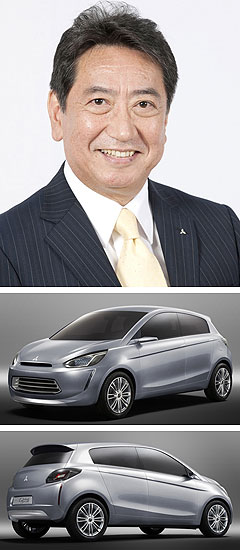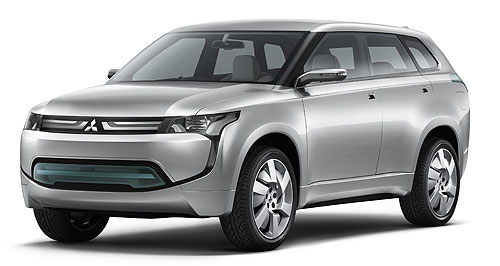Make / Model Search
Future models - Mitsubishi - PX-MiEVAIMS: Plug-in SUVs to boost MitsubishiGreen SUV: Mitsubishi will offer a plug-in hybrid version of its next-generation Outlander in 2013 – as previewed by the PX-MiEV concept unveiled at the Melbourne motor show last week. Mitsubishi expects plug-in hybrid SUVs will provide advantage in Australian market4 Jul 2011 By TERRY MARTIN MITSUBISHI Motors Australia Ltd’s new president and CEO Gen Nishina believes the company’s forthcoming plug-in hybrid SUV range will be perfectly placed in Australia, where longer travel distances potentially make hybrid a more suitable technology than full electric. While Mitsubishi is pioneering electric motoring with its i-MiEV city car, the Australian subsidiary recently confirmed it would offer a plug-in hybrid version of its next-generation Outlander in 2013 – as previewed by the PX-MiEV concept unveiled at the Melbourne motor show last week. MMAL also revealed early in June that it was awaiting confirmation of another electrified SUV – tipped to be a plug-in version of the ASX – that could arrive here in the next 12-18 months. Speaking to GoAuto at the Melbourne show last Friday, Mr Nishina said: “This is my very personal view, but the Australian people love the SUVs – your parents may have loved the station wagon, but your generation would probably prefer SUVs to the conventional station wagon – so in that regard I think plug-in hybrid is more suitable than pure electric at this moment in Australia.” Mr Nishina said the driving range was a critical factor here considering Australians typically travelled long distances and that city-dwellers routinely made trips to regional areas.  Left: Mitsubishi Motors Australia Ltd’s president and CEO Gen Nishina. Below: Mitsubishi 'Global Small' concept. Left: Mitsubishi Motors Australia Ltd’s president and CEO Gen Nishina. Below: Mitsubishi 'Global Small' concept.He said he also understood that ‘range anxiety’ was a relevant issue in Australia, which made plug-in hybrids potentially more significant here. “The human being is interesting because even every statistic says the daily average driving distance is 30km or 40km, so our i-MiEV would suffice for 99.9 per cent of people,” he said. “But, psychologically, you feel a bit insecure even when we say this car can run for 100km or 120km.” Asked whether he agreed that the vast distances in Australia and the popularity of SUVs made plug-in hybrid the most suitable technology for this market, Mr Nishina said: “My personal view is that I fully agree.” Nevertheless, he added that “it’s not denying the EV because lighter, smaller EVs are very good for a second car in urban areas”. Mr Nishina also confirmed Mitsubishi Australia’s interest in taking the electric version of the successor to its current Colt light car, which is due for release here – in conventional-engine form, at least – late next year. The first mass-market EV to reach Australia, the i-MiEV has been available for lease to selected ‘foundation customers’ since last year and will become available to the general public from August. The Colt EV is one of eight new full-electric or plug-in hybrid vehicles the Japanese manufacturer has committed to globally by 2015 – a process that will see every vehicle in the Mitsubishi range become available with an electric or plug-in hybrid variant. That also means a plug-in hybrid version of the Pajero should become available within four years. MMAL head of corporate communications Lenore Fletcher said the Australian subsidiary was likely to put its hand up for all electrified variants. “You could probably look at any vehicle in the Mitsubishi range and assume there is going to be some sort of electric or PHEV (plug-in hybrid electric vehicle) type of variant,” she said. “In terms of what Australia will do, and what we’ll be looking for, I think we’ve got a very good history of saying, ‘Yep, we’ll have that...’ And if we can possibly make a business case for it, we’re in. “We’re still going through that process at the moment.” However, Mr Nishina said the lack of federal government incentives to encourage electric vehicle sales in Australia made its product planning more difficult. “Honestly, it is very difficult for us to estimate the future volume projection because if your federal government (puts in) place a very favourable program to consumers, then volume can go from a trickle to four times, five times or even 10 times (higher). “So it’s very difficult for us to estimate the future volume with these cars for the business viability study.” Mr Nishina’s comments came as Honda Australia senior director Lindsay Smalley said his personal view was that “EV has very, very limited application in a market like Australia”. Asked whether Honda would favour a hybrid powertrain for its Jazz light car over the fully electric version, Mr Smalley said: “Hybrid gives you much more flexibility from a distance point of view, not running out of battery power halfway down the Monash Freeway or in the Burnley Tunnel. “Any solution for that type of transport needs to have some flexibility, and if it’s locked in to a finite battery charge period, I don’t see that having sufficient flexibility within the context of our market.” Mr Smalley also identified a number of issues with hybrids that were restricting sales, including vehicle price, battery longevity and resale value.  Read more27th of June 2011  AIMS: Mitsubishi electrifies in MelbournePX-MiEV plug-in hybrid headlines Mitsubishi’s show stand as MY12 i-MiEV draws near9th of June 2011  ASX might be next Mitsubishi to plug in2012 debut likely for electrified ASX as Mitsubishi cranks up plug-in models12th of April 2011  Mitsubishi on a chargePlug-in variants across all Mitsubishi Motors models by 2015All future modelsMotor industry news |
Click to shareMitsubishi modelsResearch Mitsubishi All future modelsMotor industry news |



 Alfa Romeo
Alfa Romeo Abarth
Abarth Audi
Audi Aston Martin
Aston Martin BMW
BMW Bentley
Bentley Ferrari
Ferrari Chevrolet
Chevrolet Ford
Ford Fiat
Fiat GWM
GWM Foton
Foton Hyundai
Hyundai Honda
Honda Jaguar
Jaguar Isuzu
Isuzu Kia
Kia Jeep
Jeep Land Rover
Land Rover Lamborghini
Lamborghini Maserati
Maserati Lexus
Lexus McLaren
McLaren Mazda
Mazda Mercedes-Benz
Mercedes-Benz Mitsubishi
Mitsubishi Mini
Mini Peugeot
Peugeot Nissan
Nissan Ram
Ram Porsche
Porsche Rolls-Royce
Rolls-Royce Smart
Smart Skoda
Skoda Suzuki
Suzuki Subaru
Subaru Toyota
Toyota Tesla
Tesla Volvo
Volvo Zeekr
Zeekr







Facebook Twitter Instagram